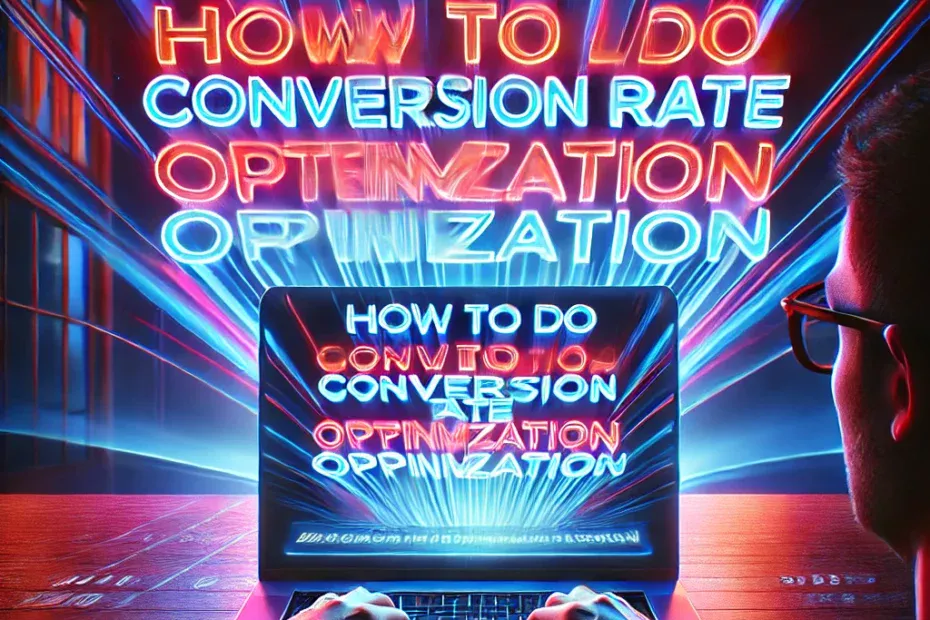Conversion Rate Optimization (CRO) is a critical strategy for improving the effectiveness of your website by increasing the percentage of visitors who complete a desired action. Whether it’s making a purchase, filling out a form, or subscribing to a newsletter, CRO can significantly enhance your site’s performance and profitability. This guide will walk you through the steps to effectively implement CRO on your website.
Why Conversion Rate Optimization Matters
- Increased Revenue: Higher conversion rates directly lead to more sales and revenue.
- Better ROI: Optimize existing traffic rather than spending more on acquiring new visitors.
- Improved User Experience: Enhances the overall user experience by making your site more intuitive and user-friendly.
- Competitive Advantage: Stay ahead of competitors by continuously improving your site’s effectiveness.
Steps to Do Conversion Rate Optimization
1. Understand Your Audience
Knowing your audience is the first step in CRO. Here’s how to gain insights:
- Demographics: Identify age, gender, location, and interests.
- Behavior Analysis: Use tools like Google Analytics to understand how visitors interact with your site.
- Customer Feedback: Collect feedback through surveys, polls, and direct customer interactions.
2. Set Clear Goals
Define clear and measurable goals for your CRO efforts. Common goals include:
- Increase Sales: Boost the number of purchases.
- Improve Lead Generation: Enhance the number of form submissions or sign-ups.
- Enhance User Engagement: Increase time spent on site, pages per visit, or social shares.
3. Analyze Current Performance
Evaluate your website’s current performance to identify areas for improvement:
- Conversion Rate: Calculate your current conversion rate (number of conversions divided by total visitors).
- Bounce Rate: Identify pages with high bounce rates where visitors leave without taking action.
- Exit Pages: Determine which pages visitors commonly exit from and why.
4. Conduct A/B Testing
A/B testing, or split testing, is a method of comparing two versions of a webpage to see which one performs better. Here’s how to do it:
- Identify Variables: Choose elements to test, such as headlines, images, call-to-action buttons, or forms.
- Create Variations: Develop variations of the chosen elements.
- Run the Test: Use tools like Optimizely or Google Optimize to run your A/B tests.
- Analyze Results: Determine which variation performs better based on your defined goals.
5. Optimize Landing Pages
Landing pages are crucial for conversions. Here’s how to optimize them:
- Clear Value Proposition: Ensure your value proposition is clear and compelling.
- Strong Call to Action (CTA): Use prominent and action-oriented CTAs.
- Social Proof: Include testimonials, reviews, or trust badges to build credibility.
- Minimal Distractions: Keep the design clean and focused on the conversion goal.
6. Improve Website Speed
Website speed plays a critical role in user experience and conversions. Here’s how to enhance it:
- Optimize Images: Compress images without sacrificing quality.
- Use a Content Delivery Network (CDN): Distribute content efficiently across global servers.
- Minimize HTTP Requests: Reduce the number of elements on each page.
- Leverage Browser Caching: Store frequently accessed files in the user’s browser for faster load times.
7. Enhance Mobile Experience
With increasing mobile usage, optimizing for mobile devices is essential:
- Responsive Design: Ensure your website is mobile-friendly and adjusts to different screen sizes.
- Fast Load Times: Optimize mobile load times as mobile users are often less patient.
- Simplified Navigation: Use simple and intuitive navigation for mobile users.
8. Use Behavioral Triggers
Behavioral triggers can help guide users towards conversion. Here’s how to implement them:
- Exit-Intent Popups: Capture visitors’ attention as they are about to leave with an offer or incentive.
- Personalized Recommendations: Use data to offer personalized product or content recommendations.
- Limited-Time Offers: Create urgency with limited-time discounts or offers.
9. Monitor and Analyze Results
Continuous monitoring and analysis are vital for successful CRO:
- Use Analytics Tools: Regularly check performance metrics using tools like Google Analytics, Hotjar, or Crazy Egg.
- Track Key Metrics: Monitor conversion rates, bounce rates, and user engagement metrics.
- Adjust Strategies: Make data-driven adjustments to your strategies based on performance insights.
10. Continuous Improvement
CRO is an ongoing process. Here’s how to ensure continuous improvement:
- Regular Testing: Continuously run A/B tests and implement the winning variations.
- Stay Updated: Keep up with industry trends and updates in CRO best practices.
- User Feedback: Regularly collect and analyze user feedback to identify new areas for improvement.
Conclusion
Conversion Rate Optimization is a powerful strategy to increase your website’s effectiveness and profitability. By understanding your audience, setting clear goals, analyzing current performance, conducting A/B testing, optimizing landing pages, improving website speed, enhancing the mobile experience, using behavioral triggers, monitoring results, and focusing on continuous improvement, you can achieve significant growth in your conversion rates.
For more tips on blogging and SEO, visit wpbloggingtips.com.

